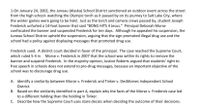Question
Can you do b please

Transcribed Image Text:1-On January 24, 2002, the Juneau (Alaska) School District sanctioned an outdoor event across the street
from the high school- watching the Olympic torch as it passed by on its journey to Salt Lake City, where
the winter games were going to be held. Just as the torch and camera crews passed by, student Joseph
Frederick unfurled a 14-foot banner that said "BONG HITS 4 Jesus." Principal Deborah Morse
confiscated the banner and suspended Frederick for ten days. Although he appealed his suspension, the
Juneau School District upheld the suspension, arguing that the sign promoted illegal drug use and the
school had a policy against displaying messages that promoted drug use.
Frederick sued. A district court decided in favor of the principal. The case reached the Supreme Court,
which ruled 5-4 in Morse v. Frederick in 2007 that the school was within its rights to remove the
banner and suspend Frederick. In the majority opinion, Justice Roberts argued that students' right to
free speech in schools does not extend to pro-drug messages, because an important objective of the
school was to discourage drug use.
A. Identify a similarity between Morse v. Frederick and Tinker v. DesMoines Independent School
District.
B. Based on the similarity identified in part A, explain why the facts of the Morse v. Frederick case led
to a different holding than the holding in Tinker.
C. Describe how the Supreme Court uses stare decisis when deciding the outcome of their decisions.
Expert Solution
This question has been solved!
Explore an expertly crafted, step-by-step solution for a thorough understanding of key concepts.
This is a popular solution
Trending nowThis is a popular solution!
Step by stepSolved in 3 steps
